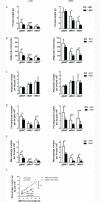BMT decreases HFD-induced weight gain associated with decreased preadipocyte number and insulin secretion
- PMID: 28445487
- PMCID: PMC5406023
- DOI: 10.1371/journal.pone.0175524
BMT decreases HFD-induced weight gain associated with decreased preadipocyte number and insulin secretion
Abstract
Experimental bone marrow transplantation (BMT) in mice is commonly used to assess the role of immune cell-specific genes in various pathophysiological settings. The application of BMT in obesity research is hampered by the significant reduction in high-fat diet (HFD)-induced obesity. We set out to characterize metabolic tissues that may be affected by the BMT procedure and impair the HFD-induced response. Male C57BL/6 mice underwent syngeneic BMT using lethal irradiation. After a recovery period of 8 weeks they were fed a low-fat diet (LFD) or HFD for 16 weeks. HFD-induced obesity was reduced in mice after BMT as compared to HFD-fed control mice, characterized by both a reduced fat (-33%; p<0.01) and lean (-11%; p<0.01) mass, while food intake and energy expenditure were unaffected. As compared to control mice, BMT-treated mice had a reduced mature adipocyte volume (approx. -45%; p<0.05) and reduced numbers of preadipocytes (-38%; p<0.05) and macrophages (-62%; p<0.05) in subcutaneous, gonadal and visceral white adipose tissue. In BMT-treated mice, pancreas weight (-46%; p<0.01) was disproportionally decreased. This was associated with reduced plasma insulin (-68%; p<0.05) and C-peptide (-37%; p<0.01) levels and a delayed glucose clearance in BMT-treated mice on HFD as compared to control mice. In conclusion, the reduction in HFD-induced obesity after BMT in mice is at least partly due to alterations in the adipose tissue cell pool composition as well as to a decreased pancreatic secretion of the anabolic hormone insulin. These effects should be considered when interpreting results of experimental BMT in metabolic studies.
Conflict of interest statement
Figures





Similar articles
-
High-fat diet decreases energy expenditure and expression of genes controlling lipid metabolism, mitochondrial function and skeletal system development in the adipose tissue, along with increased expression of extracellular matrix remodelling- and inflammation-related genes.Br J Nutr. 2015 Mar 28;113(6):867-77. doi: 10.1017/S0007114515000100. Epub 2015 Mar 6. Br J Nutr. 2015. PMID: 25744306
-
Adipose tissue inflammation and systemic insulin resistance in mice with diet-induced obesity is possibly associated with disruption of PFKFB3 in hematopoietic cells.Lab Invest. 2021 Mar;101(3):328-340. doi: 10.1038/s41374-020-00523-z. Epub 2021 Jan 18. Lab Invest. 2021. PMID: 33462362 Free PMC article.
-
Obesity Resistance and Enhanced Insulin Sensitivity in Ahnak-/- Mice Fed a High Fat Diet Are Related to Impaired Adipogenesis and Increased Energy Expenditure.PLoS One. 2015 Oct 14;10(10):e0139720. doi: 10.1371/journal.pone.0139720. eCollection 2015. PLoS One. 2015. PMID: 26466345 Free PMC article.
-
Chronic inflammation exacerbates glucose metabolism disorders in C57BL/6J mice fed with high-fat diet.J Endocrinol. 2013 Oct 28;219(3):195-204. doi: 10.1530/JOE-13-0160. Print 2013 Dec. J Endocrinol. 2013. PMID: 24029730
-
Intermedin/adrenomedullin 2 polypeptide promotes adipose tissue browning and reduces high-fat diet-induced obesity and insulin resistance in mice.Int J Obes (Lond). 2016 May;40(5):852-60. doi: 10.1038/ijo.2016.2. Epub 2016 Jan 20. Int J Obes (Lond). 2016. PMID: 26786353
Cited by
-
Bone marrow transplantation induces changes in the gut microbiota that chronically increase the cytokine response pattern of splenocytes.Sci Rep. 2022 Apr 27;12(1):6883. doi: 10.1038/s41598-022-10637-7. Sci Rep. 2022. PMID: 35477719 Free PMC article.
-
The gut hormone receptor GIPR links energy availability to the control of hematopoiesis.Mol Metab. 2020 Sep;39:101008. doi: 10.1016/j.molmet.2020.101008. Epub 2020 May 7. Mol Metab. 2020. PMID: 32389828 Free PMC article.
-
Deletion of GPR21 improves glucose homeostasis and inhibits the CCL2-CCR2 axis by divergent mechanisms.BMJ Open Diabetes Res Care. 2021 Nov;9(2):e002285. doi: 10.1136/bmjdrc-2021-002285. BMJ Open Diabetes Res Care. 2021. PMID: 34782333 Free PMC article.
-
White Kidney Bean (Phaseolus Vulgaris L.) Consumption Reduces Fat Accumulation in a Polygenic Mouse Model of Obesity.Nutrients. 2019 Nov 15;11(11):2780. doi: 10.3390/nu11112780. Nutrients. 2019. PMID: 31731665 Free PMC article.
-
Murine models of clonal haematopoiesis to assess mechanisms of cardiovascular disease.Cardiovasc Res. 2022 May 6;118(6):1413-1432. doi: 10.1093/cvr/cvab215. Cardiovasc Res. 2022. PMID: 34164655 Free PMC article. Review.
References
-
- Hotamisligil G. Inflammatory pathways and insulin action. Int J Obes. 2003;27: 53–55. - PubMed
-
- Aparicio-Vergara M, Shiri-Sverdlov R, de Haan G, Hofker MH. Bone marrow transplantation in mice as a tool for studying the role of hematopoietic cells in metabolic and cardiovascular diseases. Atherosclerosis. Elsevier Ireland Ltd; 2010;213: 335–344. - PubMed
-
- Poglio S, Galvani S, Bour S, André M, Prunet-Marcassus B, Pénicaud L, et al. Adipose tissue sensitivity to radiation exposure. Am J Pathol. 2009;174: 44–53. doi: 10.2353/ajpath.2009.080505 - DOI - PMC - PubMed
MeSH terms
Substances
LinkOut - more resources
Full Text Sources
Other Literature Sources
Medical
Research Materials

